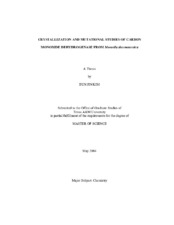| dc.description.abstract | Carbon Monoxide Dehydrogenase (CODH), also known as Acetyl-CoA synthase (ACS), is one of seven known Ni containing enzymes. CODH/ACS is a bifunctional enzyme which oxidizes CO to CO2 reversibly and synthesizes acetyl-CoA. Recently, X-ray crystal structures of homodimeric CODH from Rhodospirillum rubrum (CODHRr) and CODH from Carboxydothermus hydrogenoformans (CODHCh) have been published. These two enzymes catalyze only the reversible oxidation of CO to CO2 and have a protein sequence homologous to that of the β subunit of heterotetrameric α2β2 enzyme from Moorella thermoacetica (CODHMt), formerly Clostridium thermoaceticum. Neither CODHRr nor CODHCh contain an α-subunit as is found in CODHMt. The precise structure of the active site for acetyl-CoA synthase, called the A-cluster, is not known. Therefore, crystallization of the α subunit is required to solve the remaining structural features of CODH/ACS. Obtaining crystals and determining the X-ray crystal structure is a high-risk endeavor, and a second project was pursued involving the preparation, expression and analysis of various site-directed mutants of CODHMt. Mutational analysis of particular histidine residues and various other conserved residues of CODH from Moorella thermoacetica is discussed. Visual inspection of the crystal structure of CODHRr and CODHCh, along with sequence alignments, indicates that there may be separate pathways for proton and electron transfer during catalysis. Mutants of a proposed proton transfer pathway were characterized. Four semi-conserved histidine residues were individually mutated to alanine. Two (His116Mt and His122Mt) were essential to catalysis, while the other two (His113Mt and His119Mt) attenuated catalysis but were not essential. Significant activity was "rescued" by a double mutant where His116 was replaced by Ala and His was also introduced at position 115. Activity was also rescued in double mutants where His122 was replaced by Ala and His was simultaneously introduced at either position 121 or 123. Activity was also "rescued" by replacing His with Cys at position 116. Mutation of conserved Lys587 near the C-cluster attenuated activity but did not eliminate it. Activity was virtually abolished in a double mutant where Lys587 and His113 were both changed to Ala. Mutations of conserved Asn284 also attenuated activity. These effects suggest the presence of a network of amino acid residues responsible for proton transfer rather than a single linear pathway. | en |


